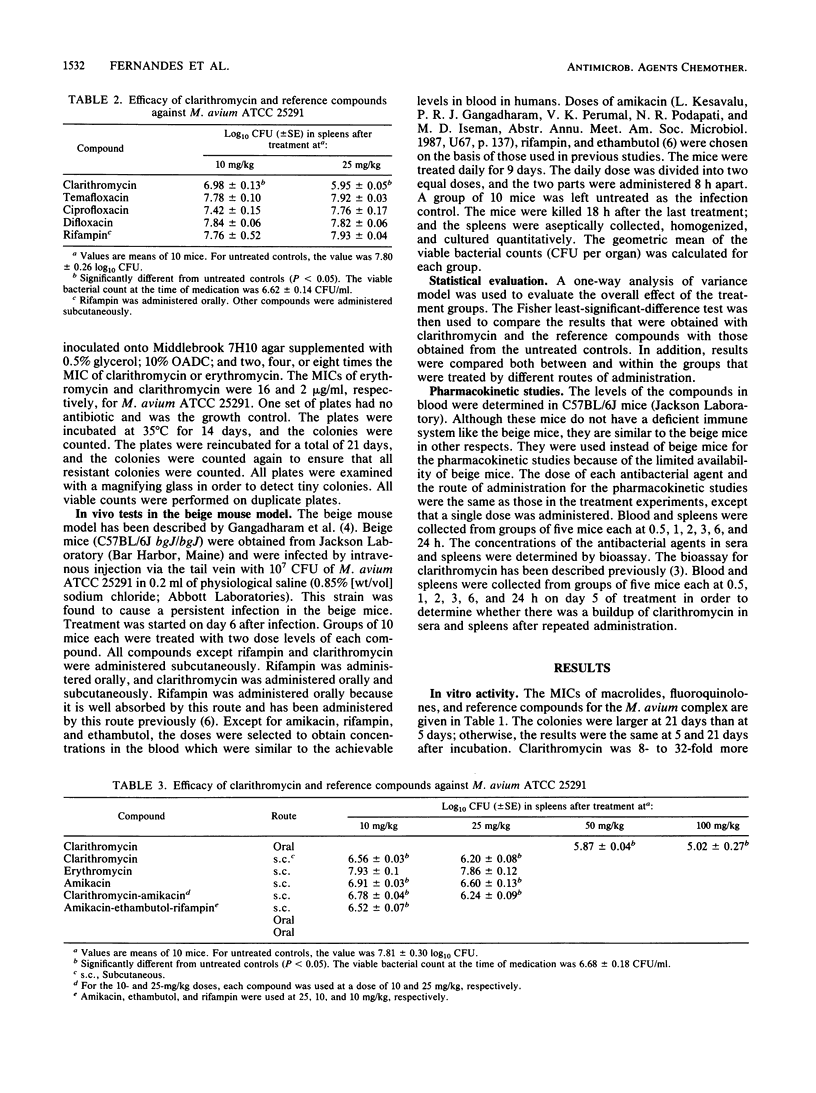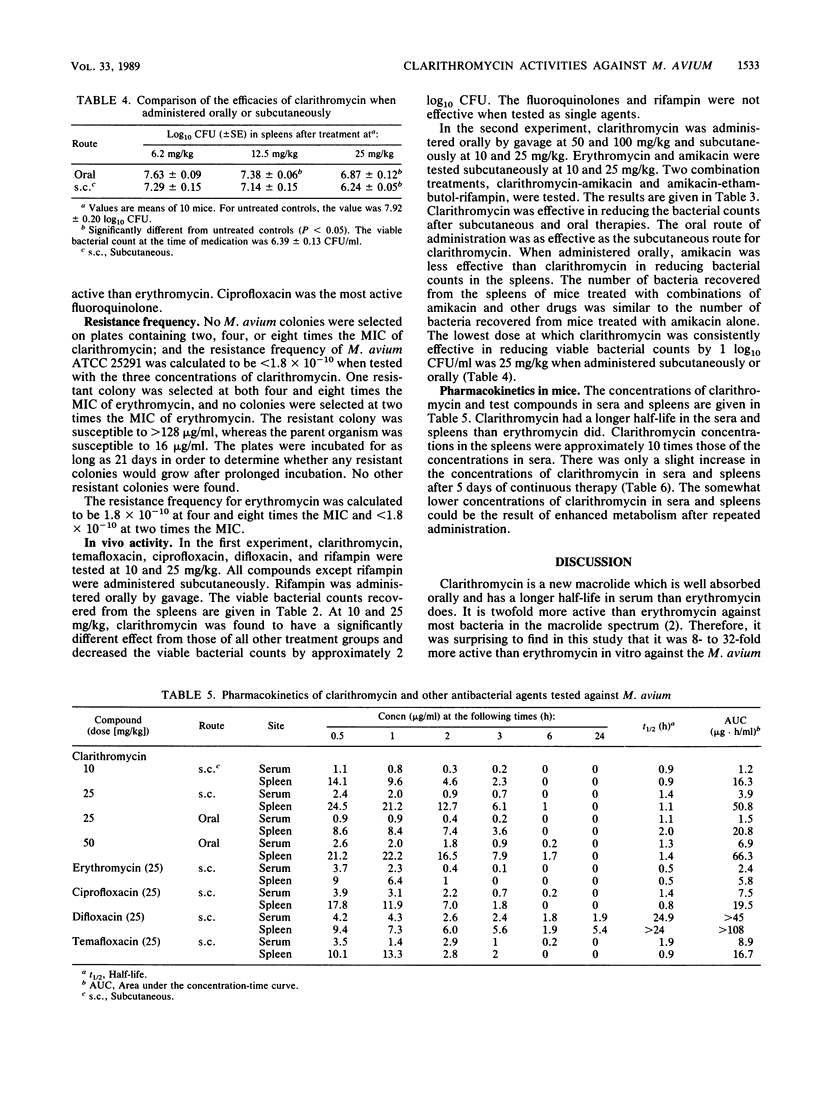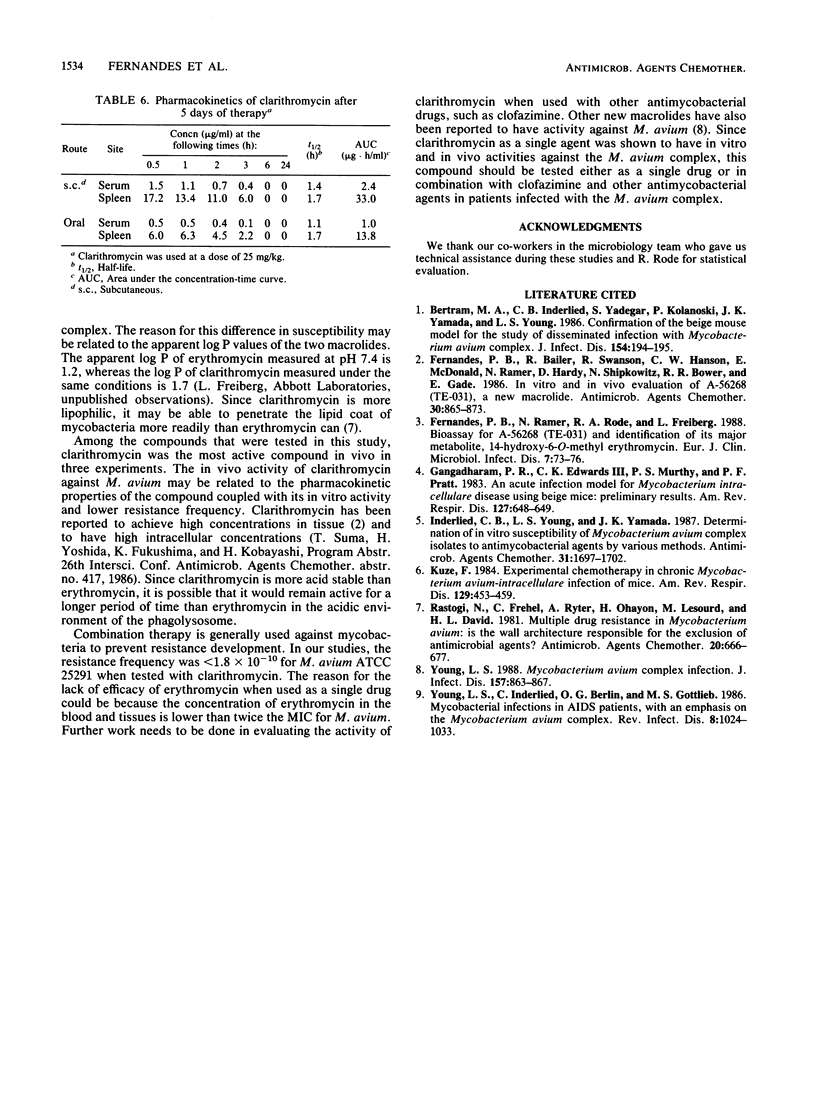Abstract
There is no effective therapy to treat Mycobacterium avium complex infection in patients with acquired immune deficiency syndrome. Clarithromycin (A-56268; TE-031) is a new macrolide which is twofold more active than erythromycin against most aerobic bacteria. In addition, higher levels in serum and tissue are achieved with clarithromycin than with erythromycin. In this study, clarithromycin, erythromycin, difloxacin, temafloxacin, ciprofloxacin, rifampin, amikacin, and ethambutol were tested in vitro and in vivo against the M. avium complex. The MICs for 90% of strains tested were 4 micrograms/ml for clarithromycin, 64 micrograms/ml for erythromycin, 32 micrograms/ml for difloxacin, 8 micrograms/ml for temafloxacin, 4 micrograms/ml for ciprofloxacin, 4 micrograms/ml for rifampin, 32 micrograms/ml for amikacin, and 32 micrograms/ml for ethambutol. Beige mice were infected intravenously with 10(7) CFU of M. avium ATCC 25291. Treatment was started on day 6 after infection and was administered twice a day at 8-h intervals for 9 days. Clarithromycin was the most effective compound in these tests and was effective in reducing the viable bacterial counts in the spleen when it was administered subcutaneously or orally at a dose of 25 mg/kg. Amikacin was the only other compound which showed activity in vivo. The peak concentration in serum at which clarithromycin was active was approximately 1.0 microgram/ml.
Full text
PDF



Selected References
These references are in PubMed. This may not be the complete list of references from this article.
- Bertram M. A., Inderlied C. B., Yadegar S., Kolanoski P., Yamada J. K., Young L. S. Confirmation of the beige mouse model for study of disseminated infection with Mycobacterium avium complex. J Infect Dis. 1986 Jul;154(1):194–195. doi: 10.1093/infdis/154.1.194. [DOI] [PubMed] [Google Scholar]
- Fernandes P. B., Bailer R., Swanson R., Hanson C. W., McDonald E., Ramer N., Hardy D., Shipkowitz N., Bower R. R., Gade E. In vitro and in vivo evaluation of A-56268 (TE-031), a new macrolide. Antimicrob Agents Chemother. 1986 Dec;30(6):865–873. doi: 10.1128/aac.30.6.865. [DOI] [PMC free article] [PubMed] [Google Scholar]
- Fernandes P. B., Ramer N., Rode R. A., Freiberg L. Bioassay for A-56268 (TE-031) and identification of its major metabolite, 14-hydroxy-6-O-methyl erythromycin. Eur J Clin Microbiol Infect Dis. 1988 Feb;7(1):73–76. doi: 10.1007/BF01962181. [DOI] [PubMed] [Google Scholar]
- Gangadharam P. R., Edwards C. K., 3rd, Murthy P. S., Pratt P. F. An acute infection model for Mycobacterium intracellulare disease using beige mice: preliminary results. Am Rev Respir Dis. 1983 May;127(5):648–649. doi: 10.1164/arrd.1983.127.5.648. [DOI] [PubMed] [Google Scholar]
- Inderlied C. B., Young L. S., Yamada J. K. Determination of in vitro susceptibility of Mycobacterium avium complex isolates to antimycobacterial agents by various methods. Antimicrob Agents Chemother. 1987 Nov;31(11):1697–1702. doi: 10.1128/aac.31.11.1697. [DOI] [PMC free article] [PubMed] [Google Scholar]
- Kuze F. Experimental chemotherapy in chronic Mycobacterium avium-intracellulare infection of mice. Am Rev Respir Dis. 1984 Mar;129(3):453–459. doi: 10.1164/arrd.1984.129.3.453. [DOI] [PubMed] [Google Scholar]
- Rastogi N., Frehel C., Ryter A., Ohayon H., Lesourd M., David H. L. Multiple drug resistance in Mycobacterium avium: is the wall architecture responsible for exclusion of antimicrobial agents? Antimicrob Agents Chemother. 1981 Nov;20(5):666–677. doi: 10.1128/aac.20.5.666. [DOI] [PMC free article] [PubMed] [Google Scholar]
- Young L. S., Inderlied C. B., Berlin O. G., Gottlieb M. S. Mycobacterial infections in AIDS patients, with an emphasis on the Mycobacterium avium complex. Rev Infect Dis. 1986 Nov-Dec;8(6):1024–1033. doi: 10.1093/clinids/8.6.1024. [DOI] [PubMed] [Google Scholar]
- Young L. S. Mycobacterium avium complex infection. J Infect Dis. 1988 May;157(5):863–867. doi: 10.1093/infdis/157.5.863. [DOI] [PubMed] [Google Scholar]


